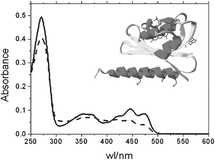Initial characterization of a blue-light sensing, phototropin-related protein from Pseudomonas putida: a paradigm for an extended LOV construct†
Abstract
The open reading frame PP2739 from Pseudomonas putida KT2440 encodes a 151

* Corresponding authors
a
Institut für Molekulare Enzymtechnologie, Heinrich-Heine Universität Düsseldorf, Forschungszentrum Jülich, Jülich, Germany
E-mail:
t.eggert@fz-juelich.de
b Dept. of Physics, University of Parma and CNR-INFM, Parma, Italy
c Max-Planck-Institut für Bioanorganische Chemie, Stiftstr. 34-36, Mülheim, Germany
The open reading frame PP2739 from Pseudomonas putida KT2440 encodes a 151

 Please wait while we load your content...
Something went wrong. Try again?
Please wait while we load your content...
Something went wrong. Try again?
U. Krauss, A. Losi, W. Gärtner, K.-E. Jaeger and T. Eggert, Phys. Chem. Chem. Phys., 2005, 7, 2804 DOI: 10.1039/B504554A
To request permission to reproduce material from this article, please go to the Copyright Clearance Center request page.
If you are an author contributing to an RSC publication, you do not need to request permission provided correct acknowledgement is given.
If you are the author of this article, you do not need to request permission to reproduce figures and diagrams provided correct acknowledgement is given. If you want to reproduce the whole article in a third-party publication (excluding your thesis/dissertation for which permission is not required) please go to the Copyright Clearance Center request page.
Read more about how to correctly acknowledge RSC content.
 Fetching data from CrossRef.
Fetching data from CrossRef.
This may take some time to load.
Loading related content
